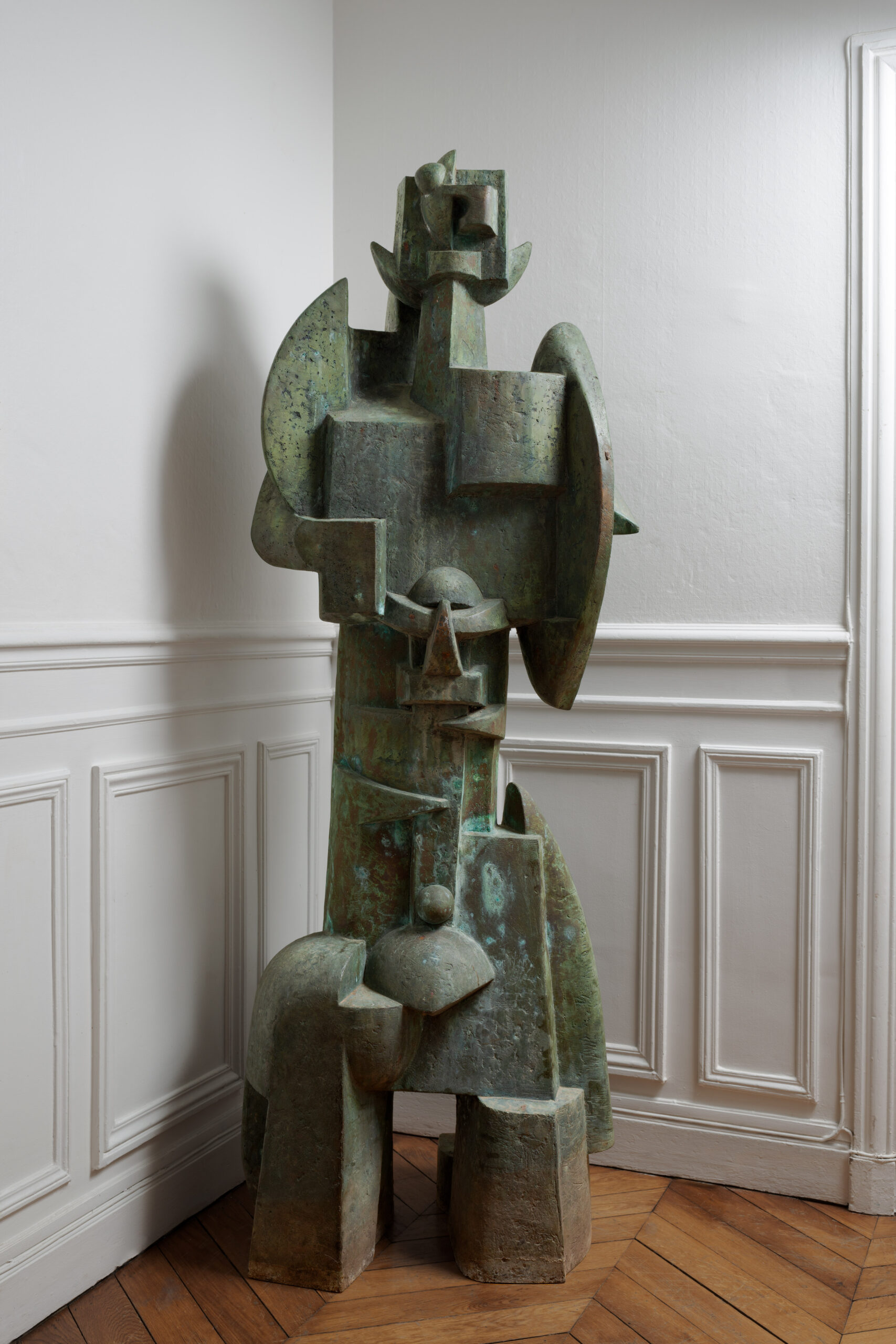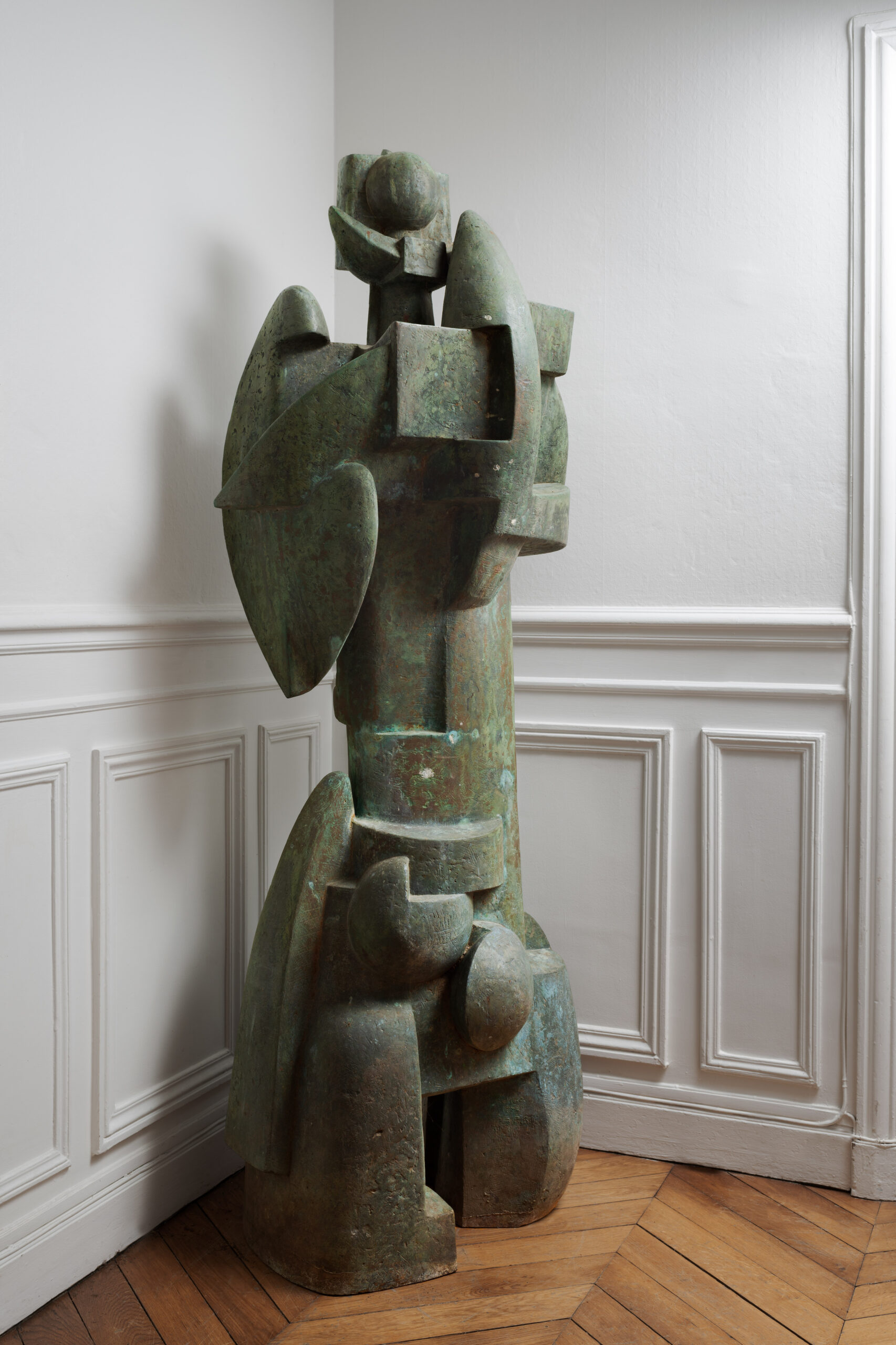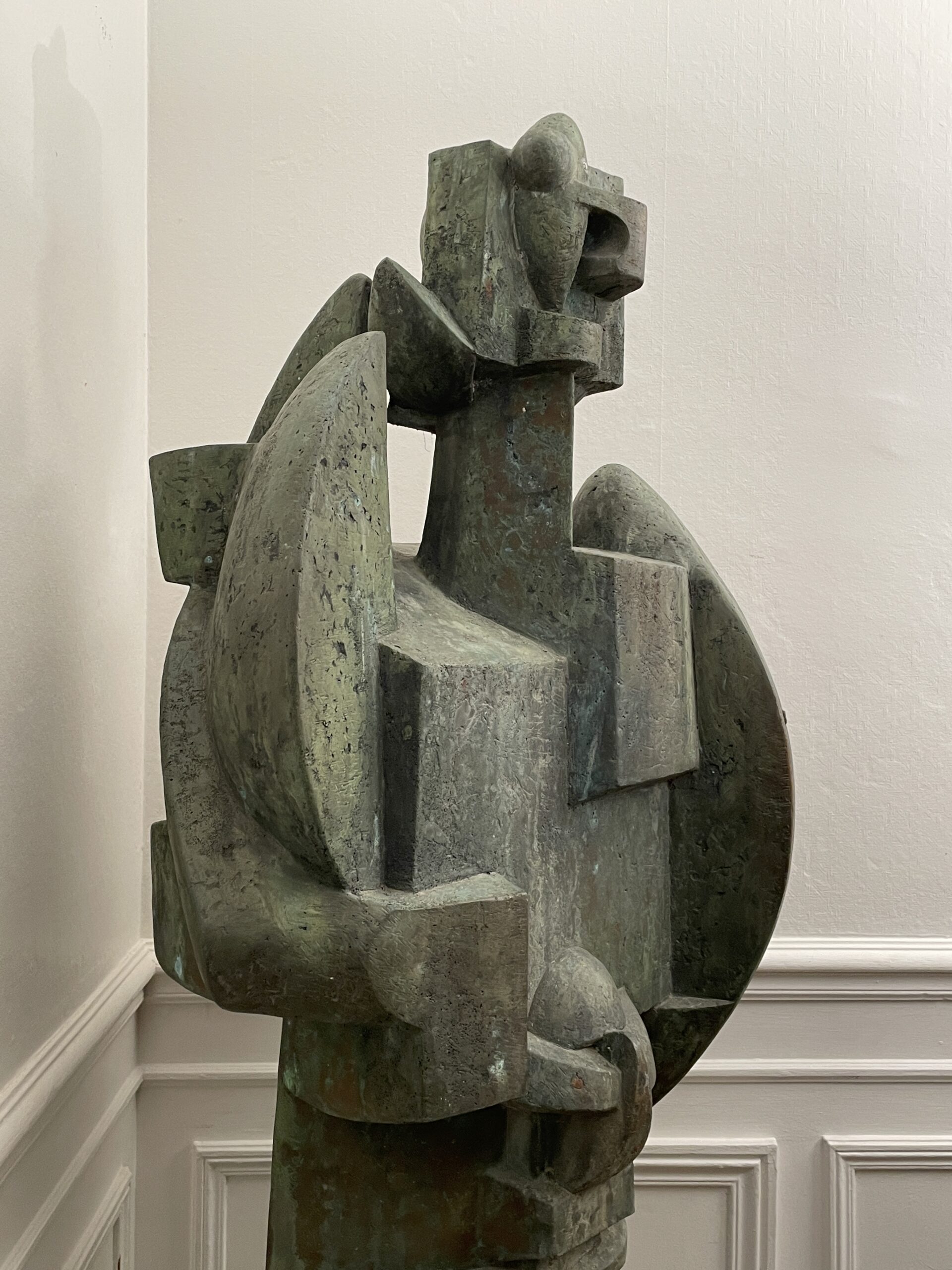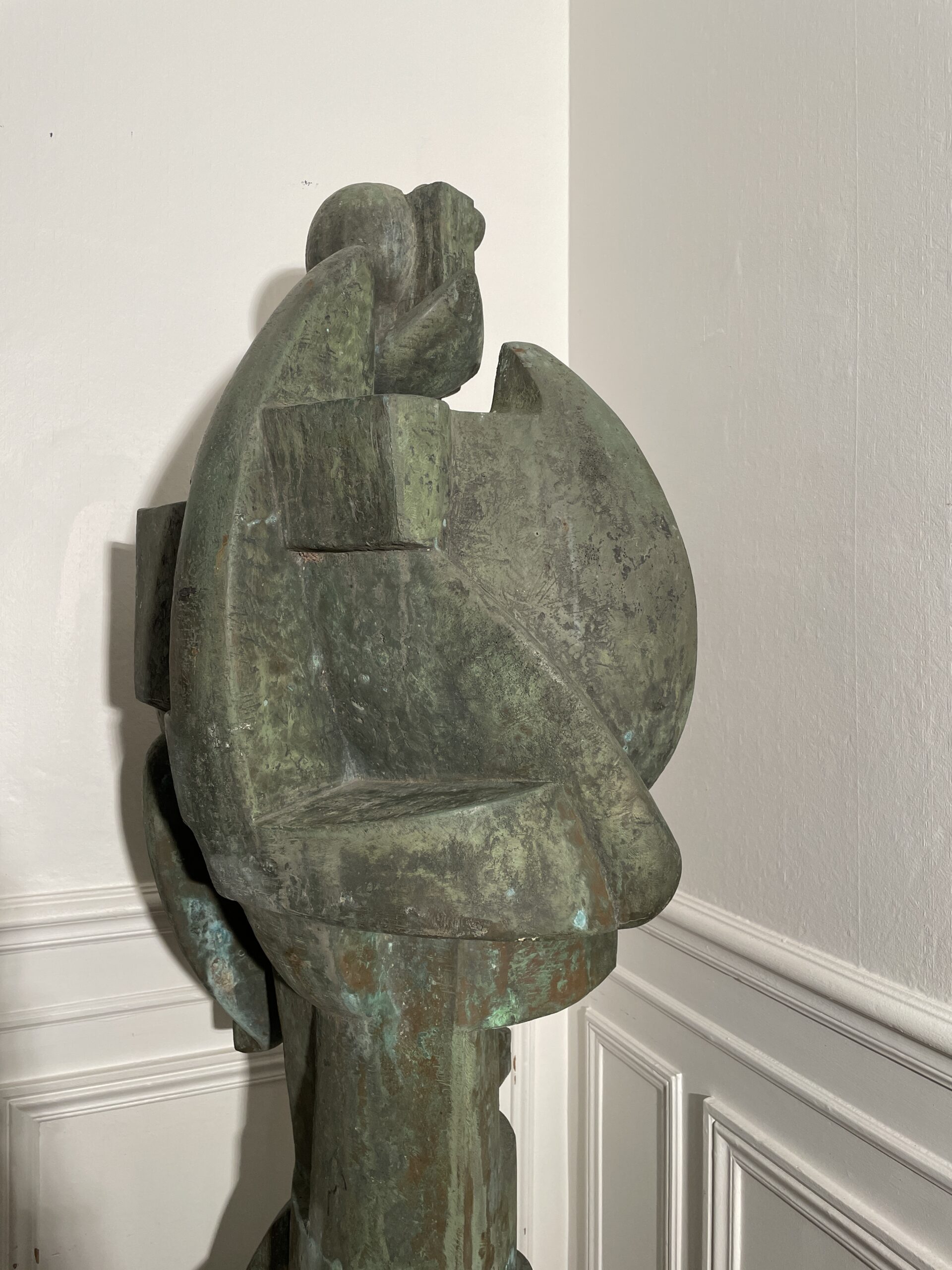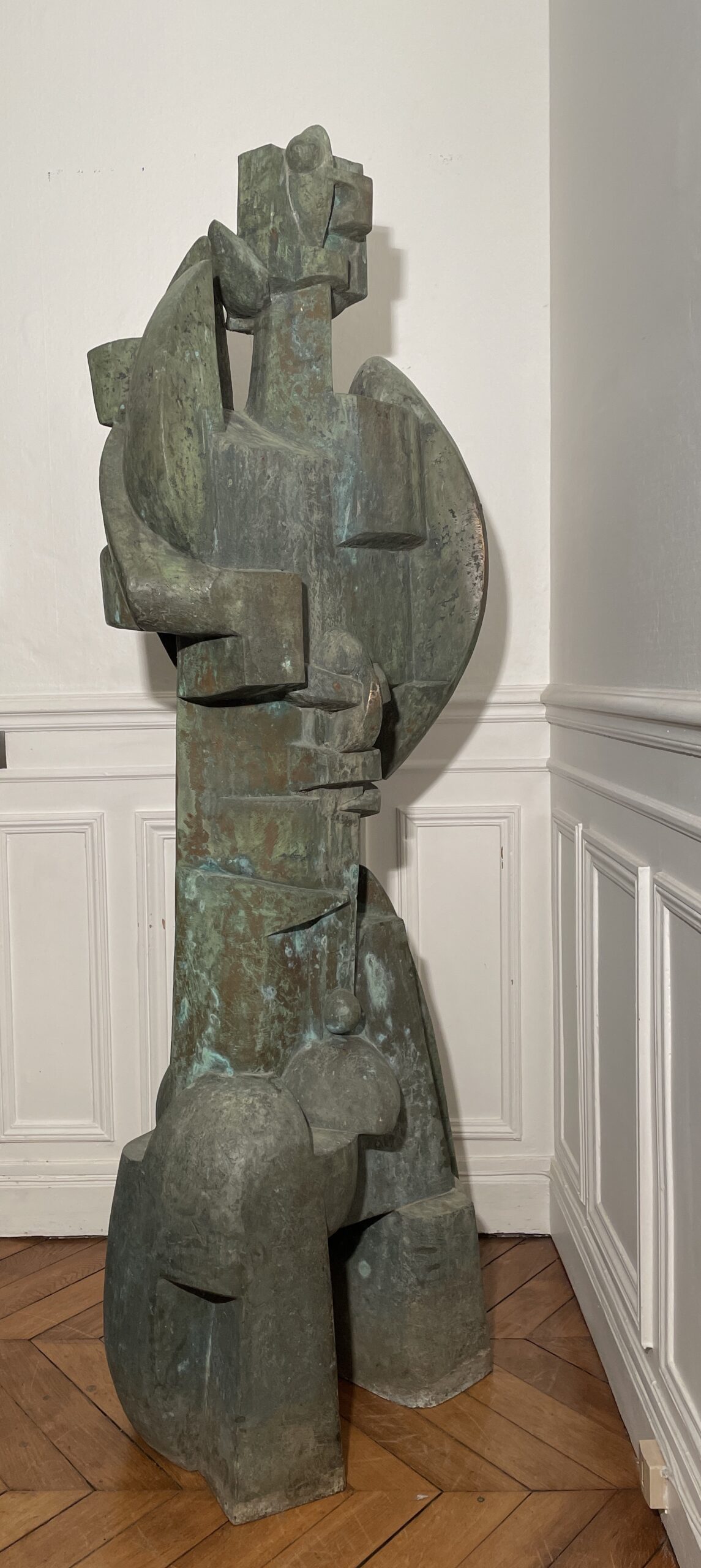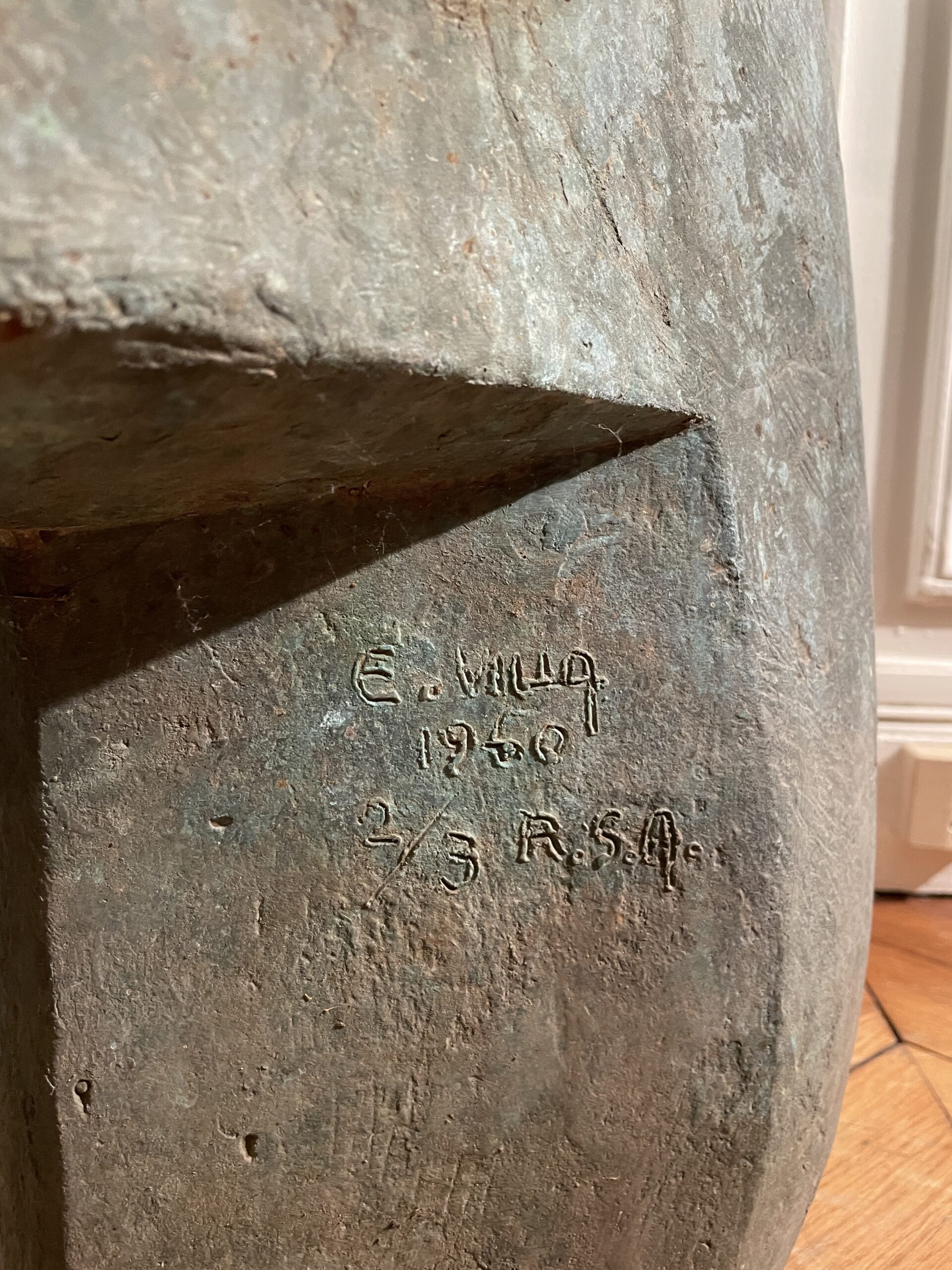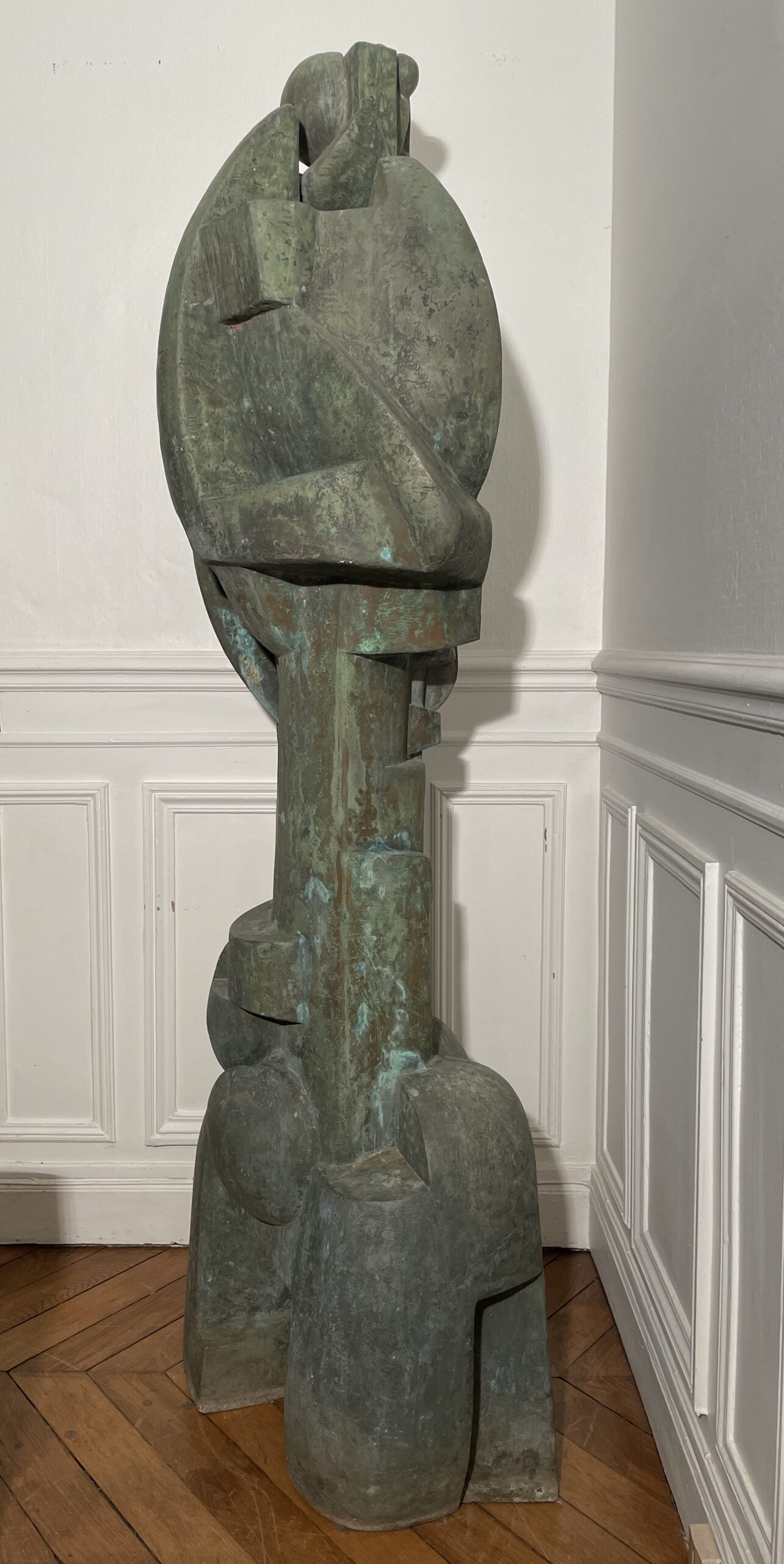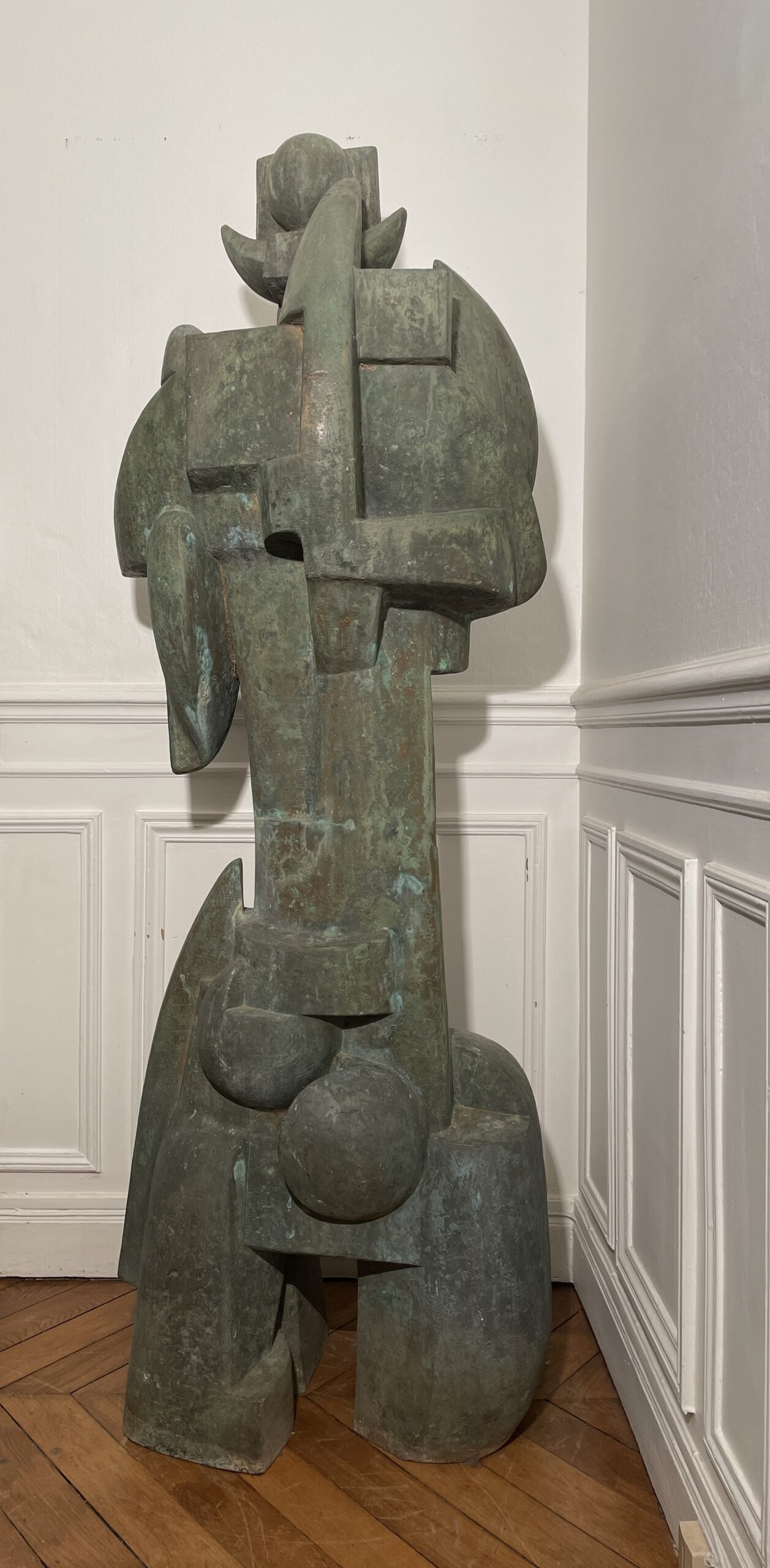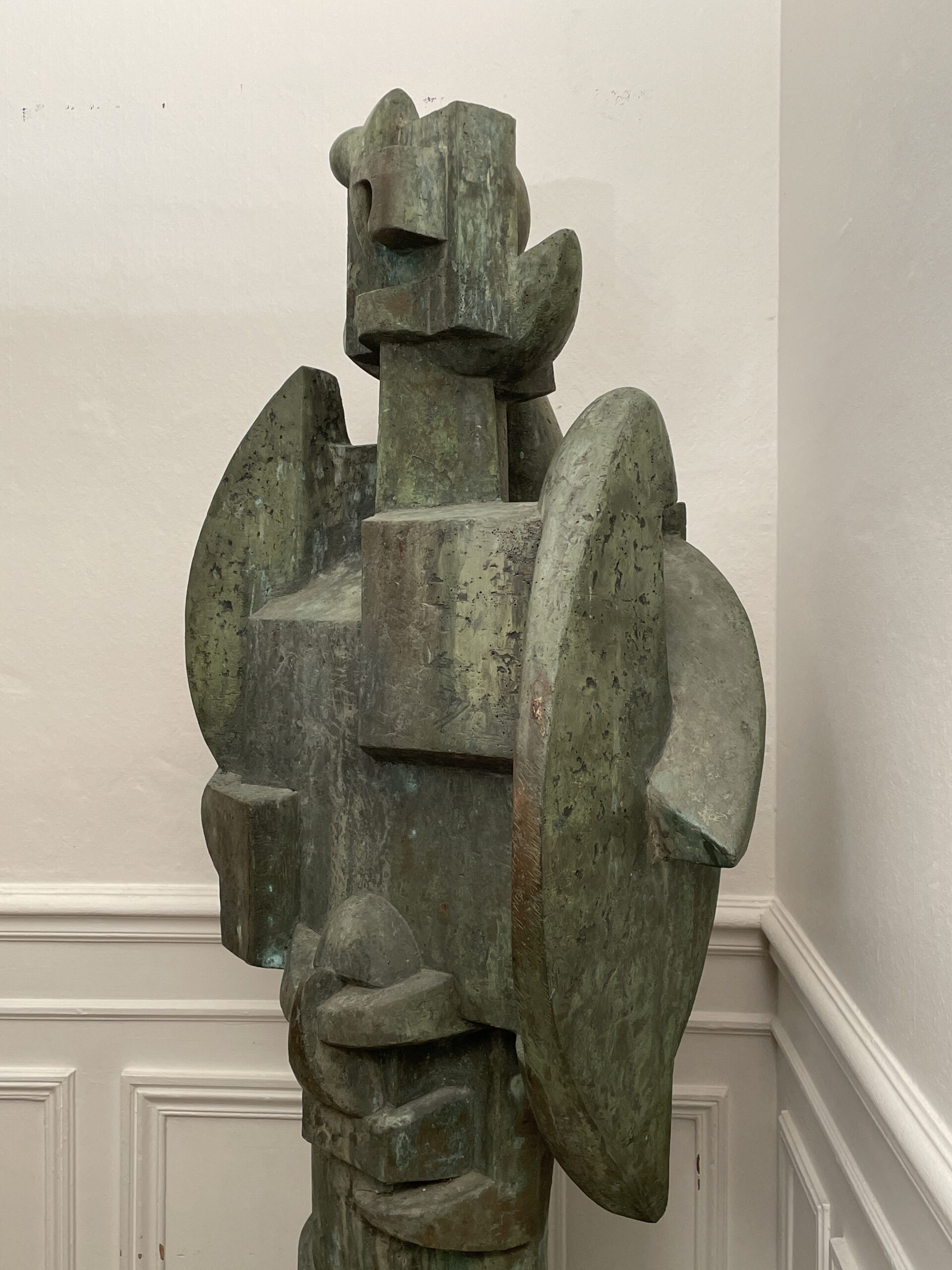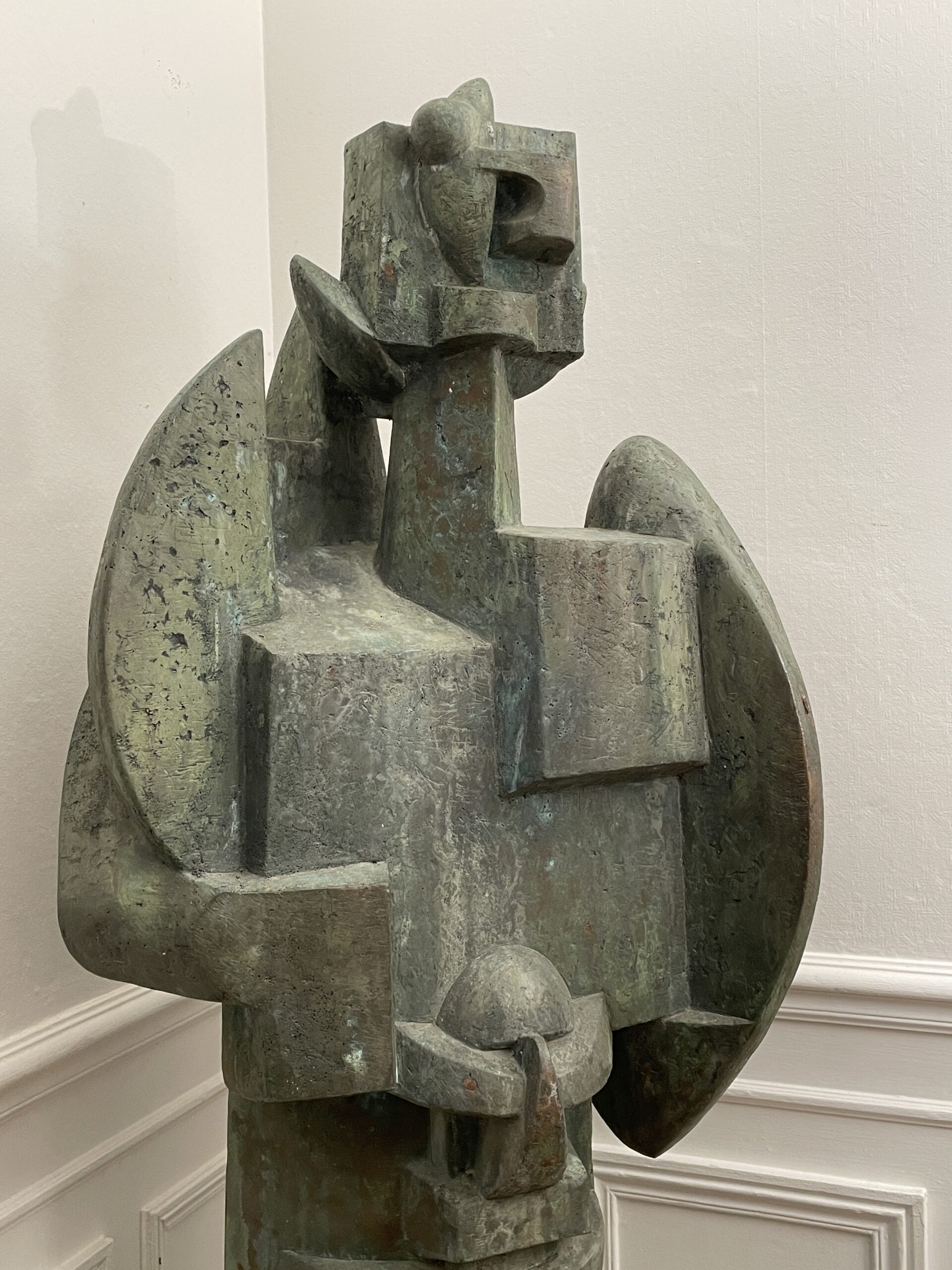Description
Standing figure, emblematic sculpture of the work of Edoardo Villa
This imposing sculpture in patinated bronze by Edoardo Villa, evokes the cubist inspiration of the artist. In addition, we find an explicit influence of African art.
The work is composed of a heap of geometric forms which, intertwined, allow us to discover the features of a human figure. We can guess, through the posture of the character and the rigor of the forms, the representation of a warrior equipped with an armor. Moreover, the man seems to be holding a shield with his left arm.
This bronze colossus reflects Edoardo Villa’s work, which was inspired both by his artistic training and his experiences, particularly during the Second World War and his stay in North Africa.
In the 1960s, when our sculpture was created, Villa’s use of Cubist and Constructivist techniques and his creative use of steel and bronze, exploring the possibilities of bent and welded metal, characterize his “break with descriptive conventions” (Berman, 2005).
This sculpture could be part of a series that the artist made in the 1960s. This series, based on the theme of the seasons, allows the artist to develop the geometry of forms to its paroxysm, making Edoardo Villa one of the major followers of Picasso Cubism.
Although this artistic movement developed in the first quarter of the twentieth century, Villa follows in the footsteps of this geometrization of human forms.
Cubism proposes a conceptual deconstruction of reality, never abstract, but multiplying the points of view on the object. Artists like Picasso or Georges Braque practiced a cubism linking academic tradition and modernity, which was taken up by Villa, without being cubist.
The history of canonical cubism ended with the Great War, which marked a break in the world of the avant-garde. Variations of Cubism also exist internationally, and in other artistic practices such as sculpture and architecture. A decisive stage in the history of art, this movement is one of the paths that led modern art towards abstraction.
In line with Cubism, he is interested in traditional African sculpture, and a “new formal language” that appreciates geometric forms in much of African sculpture, particularly in the representation of the human body, which we find in our Standing Figure.
In the years of creation of the sculpture we present, Villa abandoned the creation of a single work, to devote himself to the design of series.
Thus, this bronze colossus reflects Edoardo Villa’s work, which is inspired by both his artistic training and his experiences, particularly during the Second World War and his stay in North Africa.
Edoardo Villa : an intercultural artist
Edoardo Daniele Villa is a South African sculptor of Italian origin who mainly creates his works in bronze and steel. He began his career as a sculptor by training at the Andrea Fontini School of Art in Milan.
As a young artist, he completed several public commissions.
Villa was planning to continue his studies in Milan when he was called up for two years of military service in Rome in 1939.
With the outbreak of World War II, Edoardo Villa was conscripted into Mussolini’s Italian army. In 1940, he was assigned to North Africa and captured by British forces and wounded in Egypt. Between 1941 and 1942, Villa was again sent to Africa for four years as a prisoner of war.
During this period of incarceration, artistic workshops offered to the inmates allowed Villa to perfect his talent and to become familiar with African art. It was also in prison that the sculptor studied the work of Auguste Rodin. The summary conditions of his detention are reflected in his work, described as “emotional” by Von Maltitz. Furthermore, Esmé Berman notes that “Rodinian realism characterized the first phase of Edoardo Villa’s South African career.”
Edoardo Villa was profoundly marked by the war’s atrocity. Our sculpture could represent a warrior, illustrating the artist’s bellicose past. In fact, the geometrical shapes could remind us of the posture and the weapons of African soldiers.
It was after his liberation that the sculptor decided to stay in South Africa and develop an intercultural art, between Italy and Africa.
Villa’s work is deeply inspired by traditional African art, where he sees the invention of the stylization or abstraction of human forms.
Despite of this strong influence, Edoardo Villa never said anything about being inspired by traditional African culture. The sculptor confessed to never had any African art piece in his collection.
In his 70-year career, Edoardo Villa’s work has undergone remarkable stylistic transformations. The figurative and descriptive heads, busts and reliefs have given way to stylized abstraction and modernist forms inspired by the African artistic and cultural landscape.
His largest exhibition, “Villa at 80“, was held in Johannesburg in 1995, with nearly 300 works exhibited. Following the success of the exhibition, articles were frequently published on Villa’s work in South Africa and Italy, highlighting Villa’s impact on the development of South African art.
Today, Edoardo Villa’s public sculptures mark the metropolitan landscape of Johannesburg – his sculptures are better represented in the city than the work of any other artist.
His many works have transformed the urban landscape of many South African cities, as Villa has created a “body of work unmatched-in number, quality, and scale” (Von Maltitz and Nel 2005).
He has established himself as a prominent figure in the South African art scene, as a member of the South African Arts Association and the South African Council of Artists, and through longstanding relationships with leading universities, such as the University of Pretoria and the University of Johannesburg.
He has represented South Africa at the São Paulo Biennale and the Venice Biennale five times and has presented over 100 solo and group exhibitions worldwide.
Literature:
Berman, E. « L’élément humain dans la sculpture d’Edoardo Villa » dans Engel, EP(Ed), Eduardo Villa Sculpture, United Book Distributors : Afrique du Sud, 1980
Berman, E. Art et Artistes d’Afrique du Sud. Éditeurs de livres du sud : Western Cape, 1983
Berman, E. « Avant-propos » dans Nel, E., Burroughs, E. et Von Maltitz, A. (Eds.), Villa at 90, Jonathan Ball Publishing : Johannesburg et Cape Town, 1-13, 2005
Engel, EP(Ed), (1980), Eduardo Villa Sculpture, United Book Distributors : Afrique du Sud, 1980

